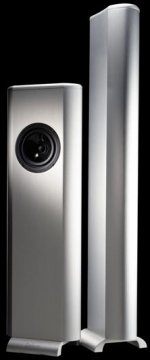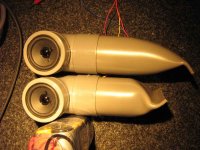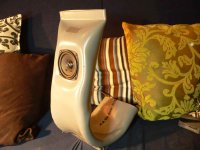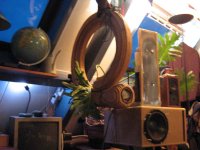I'm working on a pair of enclosures made out of 6" PVC pipe for some 5.25" drivers. They'll just barely fit on the baffle, but I think that the rounded design may actually help acoustically. (That said, I have not the foggiest idea.)
I'm worried, though, that such a narrow enclosure (roughly 5" deep) could have reflection problems. Any suggestions?

I'm worried, though, that such a narrow enclosure (roughly 5" deep) could have reflection problems. Any suggestions?
Hi Spastic,
I did something similar with 4" drivers (TL with baffle down the middle & Karlson type slot at termination); I think the rounded rear pipe helps reduce relections significantly , so much so that every time I see something drum shaped I wonder if it can be turned into a speaker cab... The resonance probs I had came from the other dimension, along the length of the pipe (I just padded each side of the baffle).
Cheers, Pete McK
I did something similar with 4" drivers (TL with baffle down the middle & Karlson type slot at termination); I think the rounded rear pipe helps reduce relections significantly , so much so that every time I see something drum shaped I wonder if it can be turned into a speaker cab... The resonance probs I had came from the other dimension, along the length of the pipe (I just padded each side of the baffle).
Cheers, Pete McK
owdi said:What's the fs of the 5.25" woofer? You may be able to do a stuffed TL.
Dan
About 50hz.
I was thinking as much - it would make for some very simple speakers, and I've got tons of parts.
Plus, mounting the baffle at a slight angle might help with this, though I have no idea as to how I would go about it.
going back to the original 6" pipes, isn't it possible to get a T junction so you get a round opening pointing forwards, into which you put the speaker? You could position this so as to get a quarter wave pipe, no?
Wondering about doing something similar with a Monacor 130AL unit which is a pretty good full range option. I have it in a reflex enclosure right now. Andy
Wondering about doing something similar with a Monacor 130AL unit which is a pretty good full range option. I have it in a reflex enclosure right now. Andy
Eusebius said:going back to the original 6" pipes, isn't it possible to get a T junction so you get a round opening pointing forwards, into which you put the speaker? You could position this so as to get a quarter wave pipe, no?
Wondering about doing something similar with a Monacor 130AL unit which is a pretty good full range option. I have it in a reflex enclosure right now. Andy
Not really. First, you run into baffle issues; second, they look awful and won't balance properly, and third, 6" PVC joints cost $12/each. (The PVC pipe was $2/ft.) I've tried it with 4" PVC pipe and some other drivers; the results were less than satisfactory.
According to my plans, I'll have 5" from the back of the baffle to the back side of the tube. I'll be using a 1" thick baffle, too, which might help a bit. Some good results were had by a Parts Express boffin using 7" woofers in 8" tubes - I'm using 5.25" woofers in 6" PVC.
Also, I could add the baffles at an angle, which would cause them to fire down to a greater degree, and might cut down on resonance a bit. I just switched to Linux (and hence have no SketchUp to model it on,) but you can see the general idea here:
http://t-linespeakers.org/projects/chris/index.html
My lametastic calculations tell me I'll need 1.9 meters (about six feet) of pipe to get a 50hz resonance, but I figure that, by stuffing, I can drop that to about four and a half feet.
454Casull said:
I'm hoping that because the driver is rounded in the back with only a flat face for the driver, I can get sphere-like diffraction - I.E; not much.
That's the other big problem with the 90-degree bends: You get ridiculously awful baffle step diffraction. My method is intended to help reduce it, at least a bit.
This type of enclosure has severe problems with internal standing waves and the enclosure acting like a one note resonator. This can be dealt with by heavily stuffing the inside of the enclosure. It needs to be overdamped which will kill the bass response.
From the perspective of the outside of the cabinet the shape may be useful.
If you are trying to make TL then it can work if you get the length right.
From the perspective of the outside of the cabinet the shape may be useful.
If you are trying to make TL then it can work if you get the length right.
Hezz said:This type of enclosure has severe problems with internal standing waves and the enclosure acting like a one note resonator. This can be dealt with by heavily stuffing the inside of the enclosure. It needs to be overdamped which will kill the bass response.
From the perspective of the outside of the cabinet the shape may be useful.
If you are trying to make TL then it can work if you get the length right.
Ah, well. Perhaps there's another way to do it?
B&W makes unusual loudspeaakers that use for the mid-bass what appears to be a sphere connected to a transmission line.
http://www.tnt-audio.com/casse/bw801e.html
They certianly seem to work well enough!
Reflection problems in undeep cabinets
We experienced several visits to our Daluso webiste due to a note from Remco.
The initial issue was "reflection problems in narrow enclosures"!
I think here is meant 'in undeep enclosured'!
I want to reflect on that.
The cabinet inside our Daluso loudspeakers (see picture) is just 3.7 inch deep.
The fitted coaxial driver just not hits the back wall.
To avoid reflections from the back wall we apply a 2" thick amount of dampening material all around the curved magnet sides.
The right and left inside walls of the cabinet are ellipt curve, which also avoids hazardous reflections and standing waves.
The total amount of dampening material insides the actuel 15 and 20 liters cabinet is barely 1 liter, not specific in use as dampening material but as blocking material, also to avoid vertical standing waves.
We strive for as less as possible dampening material to avoid energy losses.
More important is to control acoustic behaviours inside the cabinets. Therefore we only apply dampening material on critical places.
The front and rear aluminum cabinet inside walls are covered with 4mm bitume dampening sheets.
The total design, including the integrated downfiring ports, is focussed on inside and outside acoustic behaviours.
Best Regards
blank527 said:Hi,
Dampening the cabinet would be in my opinion the best possible.
Here is a site that has sort of the same design.
Not optimal though.
Greetz,
Remco
We experienced several visits to our Daluso webiste due to a note from Remco.
The initial issue was "reflection problems in narrow enclosures"!
I think here is meant 'in undeep enclosured'!
I want to reflect on that.
The cabinet inside our Daluso loudspeakers (see picture) is just 3.7 inch deep.
The fitted coaxial driver just not hits the back wall.
To avoid reflections from the back wall we apply a 2" thick amount of dampening material all around the curved magnet sides.
The right and left inside walls of the cabinet are ellipt curve, which also avoids hazardous reflections and standing waves.
The total amount of dampening material insides the actuel 15 and 20 liters cabinet is barely 1 liter, not specific in use as dampening material but as blocking material, also to avoid vertical standing waves.
We strive for as less as possible dampening material to avoid energy losses.
More important is to control acoustic behaviours inside the cabinets. Therefore we only apply dampening material on critical places.
The front and rear aluminum cabinet inside walls are covered with 4mm bitume dampening sheets.
The total design, including the integrated downfiring ports, is focussed on inside and outside acoustic behaviours.
Best Regards
Attachments
Spasticteapot said:Plus, mounting the baffle at a slight angle might help with this, though I have no idea as to how I would go about it.
Sloping the baffle does help. Execution can get tricky. The hardest part of this design was doing the baffle (one place where the ability to file MDF makes it the baffle material of choice). Your more upright baffle is probably easier than this one was.

http://www.t-linespeakers.org/FALL/toobz/index.html
You also need to account for the quarter-wave resonance (why fight it, make it an ML-TL or aperiodic TL)
dave
454Casull said:
Actually, no. Since the driver covers most of the baffle, the problem isn't that bad. The baffle step will look approximately like this:
An externally hosted image should be here but it was not working when we last tested it.
Re: Reflection problems in undeep cabinets
Hi,
It wasn't meant to be negative about it, although I said "not optimal though".
I meant to point out some examples of the enclosures that are already on the market.
I'm sorry to put it this way.
Secondly, I want to thank you though for the explanation for the theory behind this enclosure.
Sincerely,
Remco
Hi,
It wasn't meant to be negative about it, although I said "not optimal though".
I meant to point out some examples of the enclosures that are already on the market.
I'm sorry to put it this way.
Secondly, I want to thank you though for the explanation for the theory behind this enclosure.
Sincerely,
Remco
Dutch said:
We experienced several visits to our Daluso webiste due to a note from Remco.
The initial issue was "reflection problems in narrow enclosures"!
I think here is meant 'in undeep enclosured'!
I want to reflect on that.
The cabinet inside our Daluso loudspeakers (see picture) is just 3.7 inch deep.
The fitted coaxial driver just not hits the back wall.
To avoid reflections from the back wall we apply a 2" thick amount of dampening material all around the curved magnet sides.
The right and left inside walls of the cabinet are ellipt curve, which also avoids hazardous reflections and standing waves.
The total amount of dampening material insides the actuel 15 and 20 liters cabinet is barely 1 liter, not specific in use as dampening material but as blocking material, also to avoid vertical standing waves.
We strive for as less as possible dampening material to avoid energy losses.
More important is to control acoustic behaviours inside the cabinets. Therefore we only apply dampening material on critical places.
The front and rear aluminum cabinet inside walls are covered with 4mm bitume dampening sheets.
The total design, including the integrated downfiring ports, is focussed on inside and outside acoustic behaviours.
Best Regards
Hi,
You have had several interesting replies to your original query. Has this advice been of assistance to your project design? If so, are you going to build?
If you build, how soon do you expect the project to finish?
If you build, do you have the capability to measure actual performance of the loudspeakers?
If so, would you be willing to post the results to this thread?
Best,
Mark
You have had several interesting replies to your original query. Has this advice been of assistance to your project design? If so, are you going to build?
If you build, how soon do you expect the project to finish?
If you build, do you have the capability to measure actual performance of the loudspeakers?
If so, would you be willing to post the results to this thread?
Best,
Mark
Spasticteapot said:B&W makes unusual loudspeaakers that use for the mid-bass what appears to be a sphere connected to a transmission line.
It is a transmissionline, the 'sphere' is merely the part that normally is above the driver (in a classic TL enclosure) it's only added volume behind the driver...
The B&W has the advantage of leading the rear radiated waves into a smooth non-reflective (or anti-reflective) enclosure shape.
I testbuilt this one: (sadly I blew the driver to shredz

Attachments
- Status
- This old topic is closed. If you want to reopen this topic, contact a moderator using the "Report Post" button.
- Home
- Loudspeakers
- Multi-Way
- Potential issues with long, thin boxes? (With pictures!)



